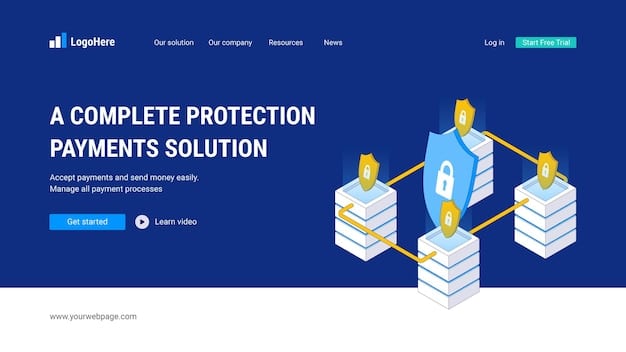Tokenization vs. Encryption: Payment Security for US E-commerce

Tokenization and encryption are both vital security measures for US e-commerce platforms to protect sensitive payment data, but they function differently; tokenization replaces data with non-sensitive equivalents, while encryption scrambles data, making it unreadable without a decryption key.
In the landscape of US e-commerce, safeguarding payment information is paramount. Two key technologies, tokenization vs. encryption: choosing the right payment security solution for your US e-commerce platform, stand out, offering distinct approaches to data protection and compliance.
Understanding the Basics of Payment Security
In today’s digital marketplace, securing payment information is not just a best practice, it’s a necessity. E-commerce businesses in the US face constant threats from cybercriminals looking to exploit vulnerabilities in payment systems. Implementing effective security measures is vital to protect sensitive customer data and maintain trust.
This section unpacks the fundamental concepts in payment security, setting the stage for a deeper dive into tokenization and encryption.
Why Payment Security Matters
Effective payment security is crucial for several reasons. First and foremost, it protects customers from fraud and identity theft. Second, it safeguards businesses from financial losses due to data breaches and fraudulent transactions. Finally, it ensures compliance with industry regulations and standards, such as the Payment Card Industry Data Security Standard (PCI DSS).
Key Concepts in Payment Security
Payment security involves a range of technologies and practices designed to protect payment data throughout its lifecycle. This includes point-to-point encryption (P2PE), EMV chip card technology, address verification system (AVS), and fraud monitoring tools. Effective payment security relies on a layered approach, combining multiple security measures to provide comprehensive protection.

- Data Protection: Protecting sensitive data, like credit card numbers, during transmission and storage.
- Compliance: Achieving and maintaining compliance with industry standards like PCI DSS.
- Fraud Prevention: Implementing measures to detect and prevent fraudulent transactions.
- Customer Trust: Building and maintaining customer trust by ensuring their payment information is secure.
Understanding the basics of payment security helps US e-commerce businesses make informed decisions about the technologies and practices they need to implement. The next sections explore two critical technologies: tokenization and encryption, examining their strengths, weaknesses, and suitability for different e-commerce environments.
What is Tokenization?
Tokenization is a security process that replaces sensitive data with non-sensitive equivalents, known as tokens. These tokens can be used in place of real data without exposing the actual information during transactions or storage.
Here’s an in-depth look at how tokenization works and its benefits for US e-commerce platforms.
How Tokenization Works
The tokenization process involves several key steps. First, sensitive data, such as a credit card number, is submitted to a secure tokenization system. The system then generates a random, unique token to represent the data. This token is stored in place of the actual data in the e-commerce platform’s systems, while the real data is securely stored in a separate, protected environment.
Benefits of Tokenization
Tokenization offers several significant benefits for e-commerce businesses. It reduces the risk of data breaches by minimizing the amount of sensitive data stored on the platform. It simplifies PCI DSS compliance by reducing the scope of systems that need to be secured. It also enables businesses to conduct transactions and process payments without exposing real data to potential threats.
- Reduced Risk: Minimizes exposure of sensitive data, lowering the risk of data breaches.
- Simplified PCI Compliance: Reduces the scope of PCI DSS requirements, making compliance easier and more cost-effective.
- Enhanced Security: Protects payment data during transactions, reducing fraud and building customer trust.
Tokenization is a valuable security tool for US e-commerce platforms looking to protect payment data and simplify compliance efforts. It provides a robust and effective way to secure sensitive information without disrupting the payment process.
What is Encryption?
Encryption is the process of converting readable data into an unreadable format, known as ciphertext. This scrambled data can only be decrypted back into its original form with a specific key.
This section examines the principles and advantages of encryption for securing payment data in the US e-commerce sector.
How Encryption Works
Encryption algorithms use mathematical formulas to transform data into ciphertext. The strength of the encryption depends on the algorithm used and the length of the encryption key. Common encryption methods include Advanced Encryption Standard (AES) and RSA. When encrypted data needs to be accessed, the decryption key is used to revert the ciphertext back to its original, readable form.
Benefits of Encryption
Encryption is essential for protecting sensitive data in transit and at rest. It ensures that even if data is intercepted or stolen, it remains unreadable without the decryption key. Encryption helps e-commerce businesses comply with data protection regulations and maintain customer trust by safeguarding their payment information.

- Data Protection in Transit: Secures data as it travels between systems and networks.
- Data Protection at Rest: Protects data when it is stored on servers, databases, or other storage media.
- Compliance Requirements: Helps meet compliance needs for data protection, such as HIPAA and GDPR.
Encryption is a fundamental security technology for US e-commerce platforms, providing essential protection for payment data. By scrambling data and making it unreadable without the correct key, encryption ensures that sensitive information remains secure, even in the event of a breach or interception.
Tokenization vs. Encryption: Key Differences
While both tokenization and encryption are used to protect payment data, they function in fundamentally different ways. Understanding these differences is critical for US e-commerce businesses to choose the right security solution for their specific needs.
Let’s highlight the key distinctions between tokenization and encryption.
Data Transformation
Tokenization replaces sensitive data with a non-sensitive surrogate value (token), whereas encryption transforms data into an unreadable format (ciphertext). The main distinction lies in how the data is handled and what replaces the original information.
Data Storage
With tokenization, the actual sensitive data is stored securely in a separate, protected environment, while the token is used in its place within the e-commerce platform’s systems. In contrast, encryption involves storing the encrypted data (ciphertext) and the decryption key, which must be protected.
Compliance Implications
Tokenization can simplify PCI DSS compliance because the e-commerce platform no longer stores sensitive data directly. Encryption also supports compliance, but requires careful management of encryption keys and algorithms to ensure data remains protected.
Tokenization and encryption each offer distinct advantages and disadvantages. The choice between them often depends on the specific security requirements, compliance obligations, and operational needs of the e-commerce business.
Choosing the Right Solution for Your E-commerce Platform
Selecting the appropriate payment security solution depends on various factors, including the size of your business, the volume of transactions processed, and specific compliance requirements.
How can a US e-commerce platform make the best choice between tokenization and encryption?
Assessing Your Needs
Start by assessing your e-commerce platform’s specific security needs and compliance requirements. Consider the level of risk you are willing to accept, the resources you have available for security management, and the potential impact of a data breach on your business.
Evaluating Costs
Evaluate the costs associated with implementing and maintaining each solution. Tokenization may involve costs for integration with tokenization service providers. Encryption may require investments in encryption software, hardware, and key management systems.
Implementation Considerations
Consider the ease of implementation and integration with your existing systems. Tokenization may require modifications to your payment processing workflows, while encryption may involve changes to data storage and transmission processes.
Choosing the right payment security solution requires careful consideration of your e-commerce platform’s needs, costs, and implementation factors. By weighing the pros and cons of tokenization and encryption, you can make an informed decision that enhances your security posture and protects your customers’ payment information.
Best Practices for Implementing Payment Security
Once you’ve chosen a payment security solution, it’s essential to follow best practices for implementation and ongoing management.
Here are some key practices to ensure your e-commerce platform remains secure.
Regular Security Audits
Conduct regular security audits to identify and address vulnerabilities in your payment systems. These audits should include penetration testing, vulnerability scanning, and reviews of security policies and procedures.
Employee Training
Provide regular training to employees on payment security best practices. Ensure they understand the importance of protecting sensitive data and are aware of the latest threats and security measures.
- Keep Software Updated: Regularly update your software and systems to patch security vulnerabilities.
- Monitor Transactions: Implement fraud monitoring tools to detect and prevent fraudulent transactions.
- Secure Data Storage: Ensure that sensitive data is stored securely, with appropriate access controls and encryption.
Implementing best practices for payment security is an ongoing process that requires continuous monitoring, evaluation, and improvement. By following these guidelines, US e-commerce platforms can minimize their risk of data breaches and maintain a strong security posture.
| Key Point | Brief Description |
|---|---|
| 🛡️ Tokenization | Replaces sensitive data with non-sensitive tokens, reducing breach risks. |
| 🔒 Encryption | Transforms data into an unreadable format, protecting it in transit and at rest. |
| ✅ PCI Compliance | Both methods aid compliance, but tokenization can simplify the process. |
| 💡 Best Practice | Regular audits and employee training are vital for maintaining strong security. |
Frequently Asked Questions
▼
Tokenization replaces sensitive data with non-sensitive tokens, while encryption transforms data into an unreadable format (ciphertext) that can only be decrypted with a key.
▼
Tokenization can simplify PCI DSS compliance because it reduces the scope of systems that need to be secured, as the actual sensitive data is stored separately.
▼
Encryption protects data in transit and at rest, ensuring that even if data is intercepted, it remains unreadable without the decryption key, thus maintaining data security.
▼
Assess your specific security needs, evaluate costs, consider ease of implementation, and weigh the pros and cons of each method to make an informed decision.
▼
Conduct regular security audits, provide employee training, keep software updated, monitor transactions, and ensure that sensitive data is stored securely with access controls.
Conclusion
Choosing between tokenization and encryption for your US e-commerce platform requires a thorough understanding of your specific security needs and compliance requirements. Both offer robust protection, but tokenization simplifies PCI DSS compliance by minimizing the storage of sensitive data, while encryption ensures data remains unreadable during transit and storage. By implementing best practices and staying informed, you can safeguard your customers’ data and maintain a strong security posture.





